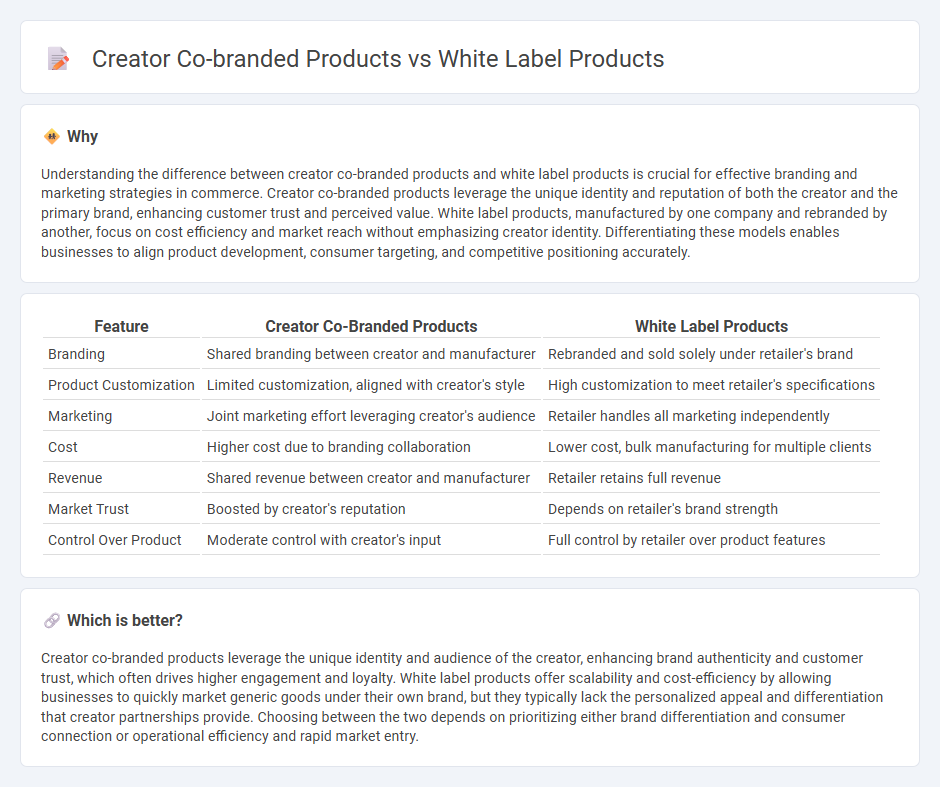
Creator co-branded products combine the unique identity of a creator with a brand's established reputation, enhancing consumer trust and engagement through authentic collaboration. White label products allow companies to rebrand generic goods, offering customizable solutions without the need for in-house production or design. Explore the key differences and benefits of each strategy to optimize your commerce success.
Why it is important
Understanding the difference between creator co-branded products and white label products is crucial for effective branding and marketing strategies in commerce. Creator co-branded products leverage the unique identity and reputation of both the creator and the primary brand, enhancing customer trust and perceived value. White label products, manufactured by one company and rebranded by another, focus on cost efficiency and market reach without emphasizing creator identity. Differentiating these models enables businesses to align product development, consumer targeting, and competitive positioning accurately.
Comparison Table
| Feature | Creator Co-Branded Products | White Label Products |
|---|---|---|
| Branding | Shared branding between creator and manufacturer | Rebranded and sold solely under retailer's brand |
| Product Customization | Limited customization, aligned with creator's style | High customization to meet retailer's specifications |
| Marketing | Joint marketing effort leveraging creator's audience | Retailer handles all marketing independently |
| Cost | Higher cost due to branding collaboration | Lower cost, bulk manufacturing for multiple clients |
| Revenue | Shared revenue between creator and manufacturer | Retailer retains full revenue |
| Market Trust | Boosted by creator's reputation | Depends on retailer's brand strength |
| Control Over Product | Moderate control with creator's input | Full control by retailer over product features |
Which is better?
Creator co-branded products leverage the unique identity and audience of the creator, enhancing brand authenticity and customer trust, which often drives higher engagement and loyalty. White label products offer scalability and cost-efficiency by allowing businesses to quickly market generic goods under their own brand, but they typically lack the personalized appeal and differentiation that creator partnerships provide. Choosing between the two depends on prioritizing either brand differentiation and consumer connection or operational efficiency and rapid market entry.
Connection
Creator co-branded products leverage the personal brand and audience trust of influencers to enhance product appeal, while white label products involve rebranding generic goods for specific markets. Both strategies maximize commerce opportunities by combining brand recognition with product customization, driving higher consumer engagement and sales. This synergy allows businesses to efficiently scale operations while capitalizing on niche marketing and brand loyalty.
Key Terms
Branding
White label products offer companies a ready-made, generic product they can brand as their own, providing quick market entry with consistent quality but limited brand differentiation. Creator co-branded products combine the reputations and audiences of both the creator and the brand, enhancing brand authenticity and customer trust through shared identity and storytelling. Explore how leveraging these branding strategies can elevate your market presence and consumer engagement.
Intellectual Property
White label products involve companies selling generic products under their brand name without ownership of the intellectual property, while creator co-branded products share IP rights between the brand and the individual creator, enhancing brand authenticity and legal protections. The division of IP rights in co-branded products enables collaborative innovation and marketing strategies, offering competitive advantages not available in white label arrangements. Explore the nuances of IP management in these product models to optimize brand value and legal security.
Revenue Sharing
White label products enable companies to sell generic items under their own brand, often involving fixed wholesale pricing with minimal revenue sharing, maximizing control but limiting profit variability. Creator co-branded products merge brand identities, allowing shared marketing efforts and revenue, typically resulting in percentage-based revenue sharing that can amplify earnings through joint promotions. Explore detailed revenue-sharing models to optimize partnerships and maximize profitability.
Source and External Links
The 13 Best White Label Products To Sell in 2025 - Shopify - White label products include reusable water bottles, cosmetics, phone accessories, fitness clothing, pet accessories, essential oils, and more, allowing brands to customize and sell products made by others under their own label to boost brand awareness.
14 Best White Label Products To Sell In 2025 - Gelato - White label products span industries like cosmetics, apparel, food, and tech, enabling businesses to rapidly expand their catalog with branded merchandise without handling manufacturing, offering flexibility and helping build brand loyalty.
15 Popular White Label Products to Sell in 2025 - Fourthwall - White label products such as apparel, shoes, hats, drinkware, and bags allow companies to enter markets quickly, reduce costs via economies of scale, customize branding extensively, and scale their product lines without manufacturing complexity.
 dowidth.com
dowidth.com